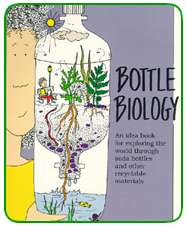![]()
Note:
Though the Bottle Biology Program officially closed its doors in 1993,
instructional materials are still being produced and distributed by the
Fast Plants staff. Below you will find a sample of Bottle Biology
activities found in the manual and available from the Wisconsin Fast
Plants Program.
Discover the world in a bottle! Hands-on, eyes-on, nose-on, mouths-on, minds-on: If you combine science with a soda bottle, what do you get? Two liters of soda pop orbiting Earth might be one result. But did you know you can use bottles to create ecosystems, explore the concept of niche, and model a lakeshore? You may have made a tornado in a bottle, but have you used bottles to breed fruit flies and spiders, to observe the adventures of slime molds, or to pickle your own cabbage? Have you made a bottle microscope, a bottle timer, or a pair of bottle tweezers? Bottle Biology is an "idea book," full of ways you can use recyclable containers to learn more about science and the environment. The projects in this book promote science as a tool everyone can use to explore the world. These explorations can be integrated with history, art, music, and other creative endeavors.
Bottle
Biology Activities : "Bottle Anatomy 101" - This activity gets beginners started in the 'basics' of taking apart, cutting and connecting the plastic bottles that are the primary material for Bottle Biology experiments.
Your students have followed their Fast Plants through their life cycle - from germination, growth and development, and finally harvesting seeds from the dried plants. What is there left to do? In fact, the last stage of the plant's life cycle remains to be seen - that of decomposition. Using the dried Fast Plant's debris and some simple tools, construct a 'compost column' to observe this process.
What important role do worms play in the natural processes of decomposition and recycling? Construct a 'home' for your worms out of a plastic soda bottle, newspaper, scissors, nails and other materials, and observe the process of vermicomposting. Explore the complexities of ecosystems such as wetlands, prairies, or deserts by constructing your own ecocolumn out of a plastic soda bottle, scissors, tape and other easy to find materials. There is an unlimited amount of things to learn from observing these simple models of more complex ecosystems that exist around the world.
Conjure up the magnificent tropical rainforests right in your own classroom. Using houseplants, such as moss fern and Swedish ivy, plan and create a tropical Eco-Column, modeling each chamber on a different rainforest layer.
How are land and water systems connected? Explore one of the major links - water - by constructing a TerraAqua column out of a plastic soda bottle.
Capture the fascinating world of the predator and its prey, using preying mantises, spiders or carnivorous plants as your predators, and fruit flies as your prey. Learn how to successfully raise a preying mantis, or grow a healthy Venus flytrap.
Construct a fruit fly trap out of a plastic soda bottle and you have a wonderful way to observe the fruit fly's development and reproduction in the classroom.
What exactly is a niche? Students can explore this deceptively difficult concept when they construct their Niche Kit out of a 2-liter bottle and film cans. What do you get when you combine cabbage, chili peppers, salt and garlic? You get a popular Korean dish called Kimchee, but you also learn about the process of lactic acid fermentation, present in the ancient form of food preservation - pickling.
The ground you walk on seems solid, so how can earthworms breathe under there? Why does rainwater just soak right into the earth? Using soda bottles and film cans, students can investigate the soil beneath their feet in the three activities provided here: Film Can Mysteries, The Sedimentation Bottle, and Cooking with Soils.
Build your own bottle cap
garden dome! Activities: To Know a Moss - Grow a Moss, Kalenchoe kids-
mother of millions, and Liverwort sports |